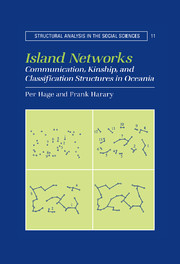1 - Island networks and graphs
Published online by Cambridge University Press: 06 August 2010
Summary
In the course of transforming verbal propositions into images many things are made explicit that were previously implicit and hidden.
Herbert A. Simon, Models of My LifeOceanists have increasingly come to recognize the limitations of the laboratory analogy that treats island societies as isolated experiments in adaptive radiation. Reconstructions of regional exchange systems (Hage and Harary 1991), archaeological evidence of sustained inter-island contacts (Kirch 1988a), firsthand accounts of traditional voyaging techniques (Lewis 1972), and the evident contradiction between neoevolutionist assumptions and the facts of Oceanic ethnography and prehistory (Friedman 1981) conduce to a network perspective that views island societies as elements of communication systems. Most islands in the Pacific are, in fact, distributed in groups, and most island societies are, or once were, connected to other island societies – as colonists, trade partners, tributaries, allies, wife-givers, and in various other ways. In acknowledging the importance of these connections many researchers, including anthropologists, archaeologists, and linguists, are now using or recommending the application of network concepts to answer a range of fundamental questions concerning
the settlement of island groups (Levison, Ward, and Webb 1973; Ward, Webb, and Levison 1976; Green 1979; Kirch 1988a; Irwin 1992);
the location of trade centers (Irwin 1974, 1978, 1983; Kirch 1988b; Hunt 1988);
the development of social stratification and social complexity (Reid 1977; Friedman 1981; Kirch 1984a; Lilley 1985; Graves and Hunt 1990);
the differentiation of cultural complexes (Green 1978);
the diversification of dialects and languages (Pawley and Green 1984; Marck 1986);
the distribution of physical and cultural traits (Terrell 1986);
the selection of subsistence practices (Harris 1979);
the evolution of kinship structures (Epling, Kirk, and Boyd 1973; Marshall 1984).
- Type
- Chapter
- Information
- Island NetworksCommunication, Kinship, and Classification Structures in Oceania, pp. 1 - 21Publisher: Cambridge University PressPrint publication year: 1996



